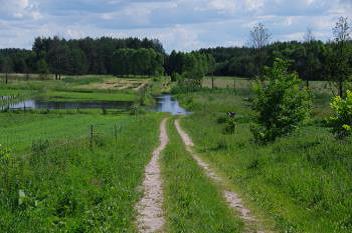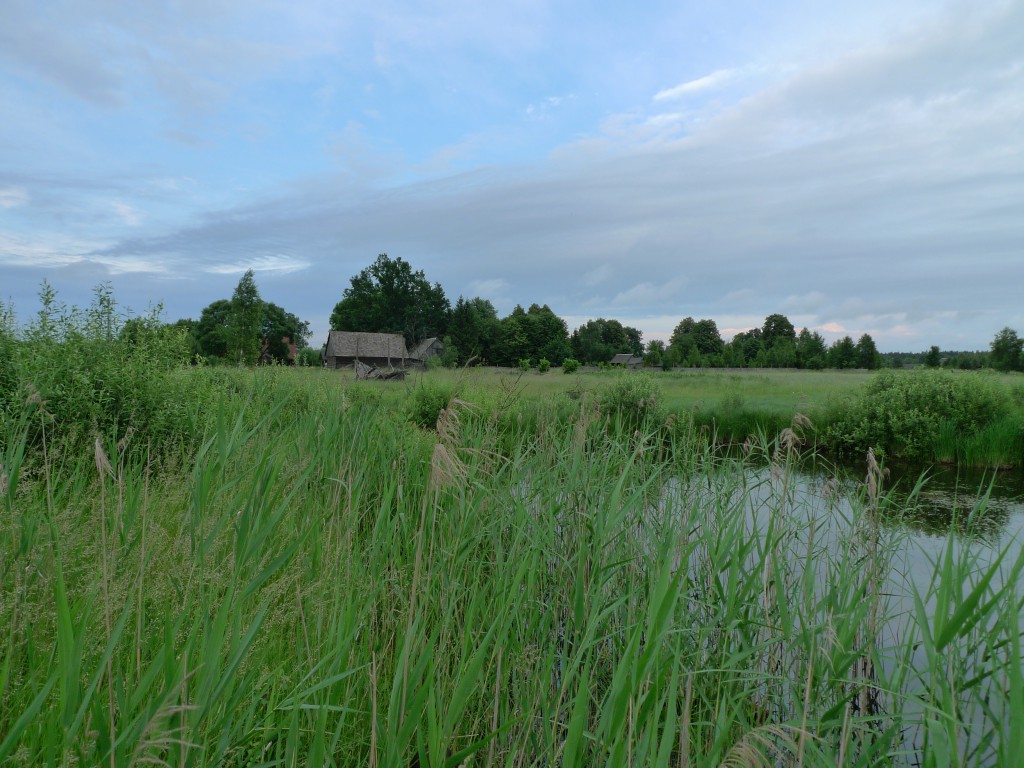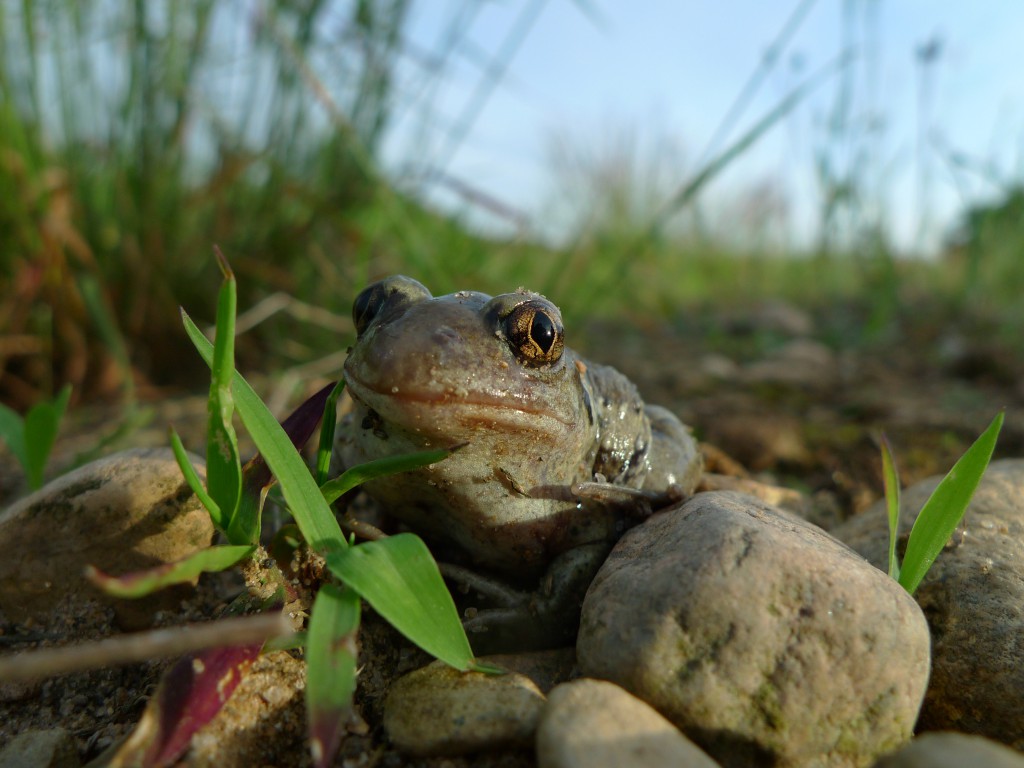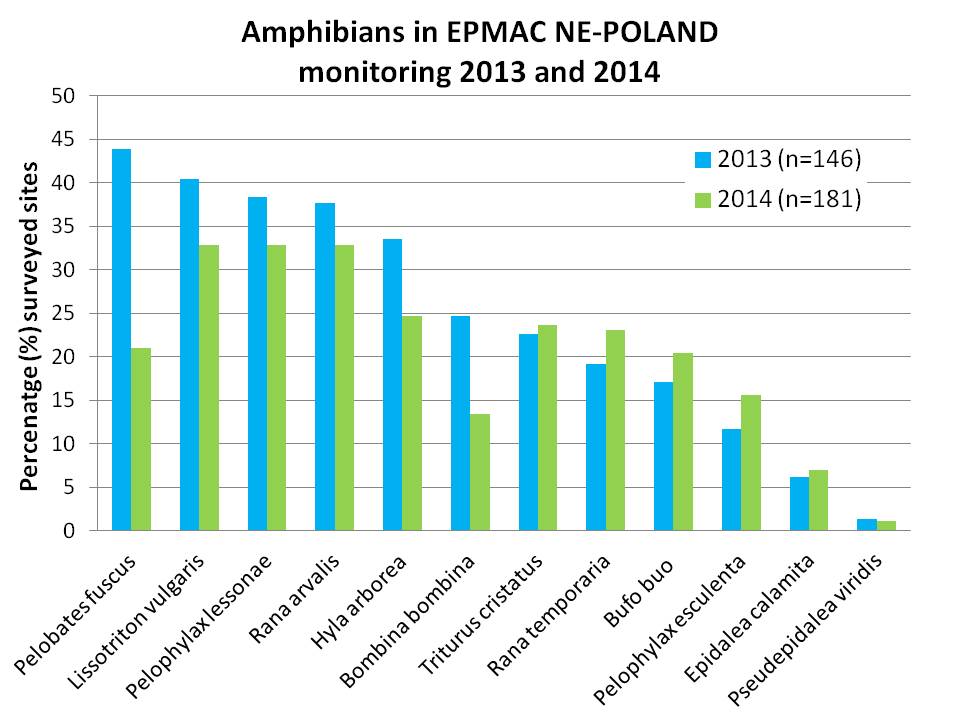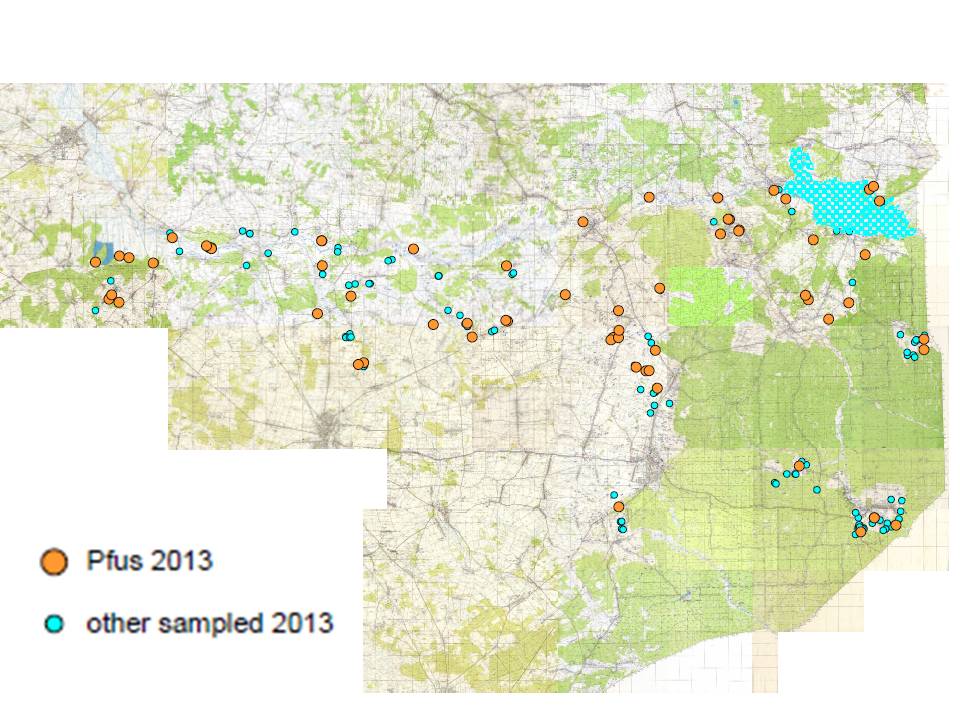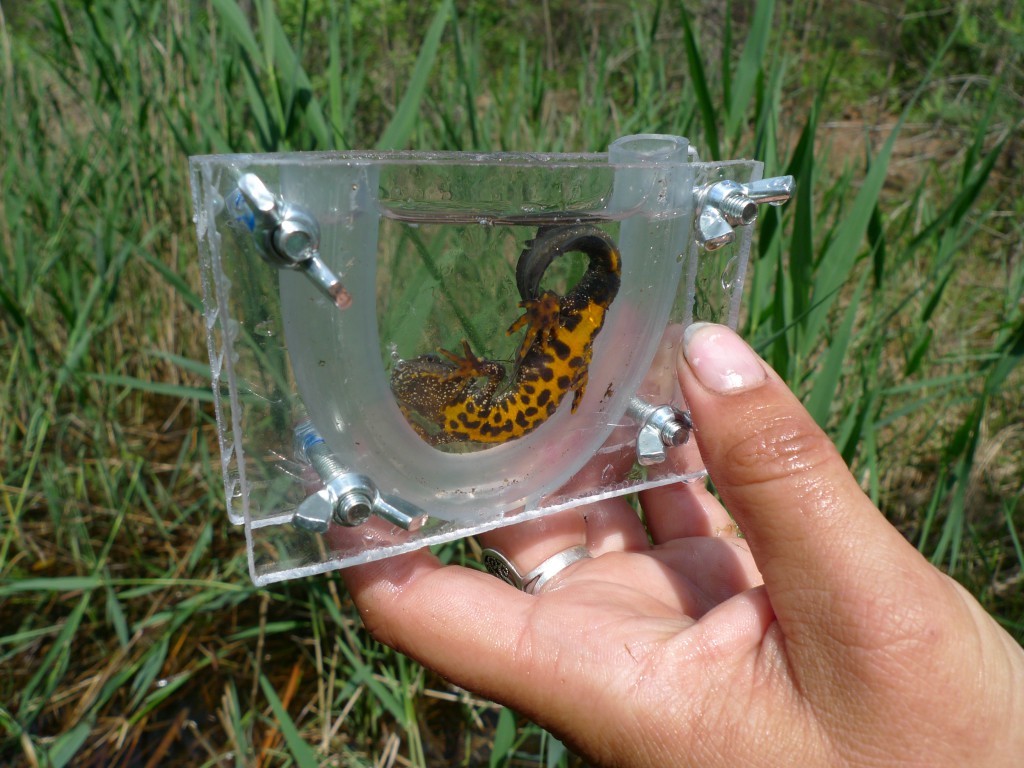POLAND – BIALOWIEZA NATIONAL PARK, NAREW UPPER RIVER VALLEY LANDSCAPE PARK AND EXTENSIVELY USED AGRICULTURAL AREAS IN NE POLAND
Back ground and objectivesThe basis objectives of the monitoring in north-east Poland are:
•To increase knowledge and experience on the recognition of amphibians and their habitats of the European lowland in all life stages
•Collect comparable data for long term evaluation of the status and dynamics of amphibians and their habitats
• Evaluate the status of rare amphibians in distinctive ecosystems in north-eastern Poland (Bialowieza forest area, Narew upper river valley, agricultural area)
•Define and prioritise actions for amphibian conservation in the region.
Methodology
Description of the area
The region in north-eastern Poland is an important reference area for nature conservation in the European lowland, including the Netherlands. The geomorphology, natural and hydrologic processes and dynamics are similar to those that have formed the basis of most of the western European landscape. The climate is slightly more continental and soils are younger and more calcareous than more western European lowland. In comparison to other regions in Europe, the lowland areas in Podlasie (north-eastern Poland) have undergone very gradual changes on a relatively small scale. More western regions have undergone massive landscape reforms (drainage, land consolidation, large scale intensification and wide scale and intensity of chemical pesticides and fertilizers). The natural structures and underground in Podlasie has had a continuous use and human influence. The scale and fluctuating gradients of intensity have varied and developed in relation with the natural and sometimes cultural dynamics and climate. As a consequence the region has a rather natural hydrology and waters with natural nutrient levels and chemical composition. Efficient and deep drainage with disruption of underlying clay layers on a landscape scale are rare. The natural shaped headwaters, streams and rivers with relatively clean and low nutrient rich waters dominate the area. In the monitoring there four areas are included:
The Bialowieza forest area consists of the primeval forest of Bialowieza. The strict reserve and areas of the surrounding forest are well known for their old age, natural structures and forest dynamics. In the large forest complex of over 25 square kilometres there are several glades with more open habitats. These used to be open agricultural areas around houses, hamlets and villages, but in the last decade’s much of the agricultural activities have ceased. The farmer and foresting community is gradually changing and tourism is becoming more important on shaping the landscape. The smaller glades, further from the strict reserve, have a more farming and forestry community. The amphibian community in the Bialowieza forest and glades used to have 12 species. In the forest, with natural streams, floodings and wet forest depressions, the more common amphibian species (Rana temporaria, Rana arvalis and Bufo bufo) dominated in the nineties. The open areas had populations of all the more rare species, though Bufo calamita and Bombina bombina had recently gone extinct. Already, in the late nineties several waters were improved for rare amphibians, and in the past decade over ten ponds have been dug for rare amphibians. These conservation actions have continued and last winter over ten new ponds were dug in Bialowieza glade for amphibians (Lars Briggs).
Agricultural areas along the Bialowieza forest (Hajnowka to Nowosady)
West of the primeval forest and protected forests of Bialowieza, there is a fast agricultural landscape that has been used for agriculture for thousands of years. The landscape is rolling and has sandy soils with moraine clay layers near the surface. Scattered there are villages, hamlets and isolated farms. The land use is diverse with a large part of the population working with agriculture, including dairy farming and related grasslands, meadows, wheat and potato production and scattered forest complexes. The small stream valleys that contribute to the Narew river in the north and to the river to the south have been transferred to more canal shaped streams in the course of the last century. In the forest complexes and meadows, head waters still appear in forests and sedge swamps. In the nineties the entire amphibian community had large meta-populations in the landscape using the whole spectrum of (temporary) available waters as well much of the terrestrial surroundings within kilometres from the semi-aquatic sites. Smaller and larger sand excavations for multi-purpose uses were among the more valuable habitats. Fields with inundations and temporary ditches were used by most species of open habitats, such as Bufo calamita, Bufo viridis and Pelobates fuscus. While Triturus cristatus was a relatively rare species, occurring mainly in and near forests. Bombina bombina and Hyla arborea were both common in the warmer and clean waters. It was expected that we would observe a strong intensification of the land use in this area and related that with a strong decline of the more delicate amphibian species of conservation concern. No amphibian conservation actions had been undertaken in the previous decades.
Upper river valley Narew and agricultural surroundings (north of Bialowieza)
The surrounding of the Upper Narew River valley was not protected in the nineties. Most of the head waters in this part of the Narew lowland river come from forested surroundings. Though a large artificial lake (Siemianowka) was made creating a lake with a flood zone with water deriving from (agricultural?) areas from the neighbouring Belorussia. The surrounding of the lake and valley north of the Bialowieza forest has changed only gradually. The open areas had small hamlets in which most people lived from the surrounding land (cattle and agriculture) in the nineties. The close vicinity of the large forest complex influences wild life on the landscape (wild boars, deer, elks, etc). In the nineties the area had large populations of all amphibian species, although Bufo viridis was recorded in only a few locations. It was expected most of the land use would have extensified and that succession would have caused the decrease of open sun exposed lands. Several amphibian conservation actions were undertaken (Lars Briggs) and ponds were dug in the past decade.
Upper river valley Narew and agricultural surroundings (Narew-Suraz)
More west of the forest area, in and surrounding the Upper River valley, the valley is surrounded by smaller forest complexes and larger agricultural areas. The wide valley, with a relatively natural flowing river and floodings in this part would have been used entirely in relation with cattle. Larger areas of the valley showed a change in use during the nineties and the mowing and grazing clearly were reduced (less cows, horses, sheep and goats). Along the edge of the valley the villages mainly lived from dairy farming activities, but all inhabitants also grew much of their own food and wood. An extensification of the valley (overgrowing by reeds and bushes) and intensification of the surrounding agricultural areas was expected. No amphibian conservation actions were undertaken.
146, 181 and 105 sites were systematically dip-netted or inspected in 2013, 2014 and 2015respectively, including newly dug amphibian habitats. All 12 species that were previously known from the area were observed. Although the method focused on the larvae and juveniles, all species were also observed in their adult life stage. The preselection and earlier surveys had focused on the populations of amphibians of highest the conservationconcern in Europe (8 target species): Triturus cristatus, Pelobates fuscus, Bombina bombina, Bufo/Epidalea calamita, Bufo/Pseudepidalea viridis/variabilis, Hyla arborea, Rana arvalis and Rana lessone. The eight species of the conservation concern inhabit relatively nutrient poor and less permanent waters, while the less threatened European lowland species survive especially well in eutrofic and more permanent waters. In north-eastern Poland the nutrient poor habitats prevail in stagnant waters outside the influence of rivers and streams. Most species were commonly recorded (figure 1 and figure 2). Figure 2 illustrates how common Pelobates fuscus is in the landscape (2013), but four times less populations were detected in the dry year 2015. Less recorded were Bufo/P. viridis/variabilis and Bufo/E. calamita. Both species could go unobserved by the established method that had focused on previously known breeding sites. In function of the availability of the water and the pioneer stage of the habitats, they use one site or another for breeding. Additional earlier spring surveys in 2014 gave similar low results though. The results indicate that where Bombina bombina has smaller populations, they are difficult to detect in years with few water (see presentation EPMAC EUROPE).
Species Status indication 1999 : 2013
{ First indication on the status of the populations of target amphibians of conservation concern by comparison of number of populations (incl. new colonisations and extinctions) in Upper Narew River Valley between Narew and Suraz villages (1999 versus 2013).}
Triturus cristatus – Stable
Bombina bombina – Decline
Pelobates fuscus – Stable
Bufo/Epidalea calamita – Decline?
Bufo/Pseudepidalea viridis/variabilis – Decline?
Hyla arborea – Decline
Spin-offs of the monitoring
Collaborations
The EPMAC monitoring in north-eastern Poland is an initiative from Natura Cerca, Soontiens Ecology and Bialowieza Biodiversity Center. The regional government supplied authorisation to execute the monitoring of threatened and protected amphibian species. Amphi Consult provided topographical maps with prospected sites and data from the late 1990´s). The monitoring is made possible by the foreign participants that cover also the board and lodging of local participants and (professional) guides.
Next monitoring events
Planned monitoring events wil be published in the agenda on this site.
12 species of amphibians have large populations in the monitoring area in north-eastern Poland. The area includes the Biosphere Reserve and National Park Bialowieza and the protected landscape park of Narew Upper River Valley. With exception of Bufo viridis all species are common and abundant. Each species lives in distinct aquatic and terrestrial habitat. On this page pictures of the 12 species are included.
Trituturs cristatus
Lissotriton/Triturus vulgaris
Bombina bombina
Pelobates fuscus
Bufo/Epidalea calamita
Bufo bufo
Bufo/Speudepidalea viridis
Hyla arborea
Rana temporaria
Rana arvalis
Rana/Pelophylax lessonae
Rana/Pelophylax esculenta
Rana/Pelophylax ridibunda/ridibundus (not in monitoring area)
2024
This autumn several ponds were cleared from vegetation so they can function again for amphibians. This pond was dug over 25 years ago for amphibians. Now it can function for rare amphibians again for 20 years!

